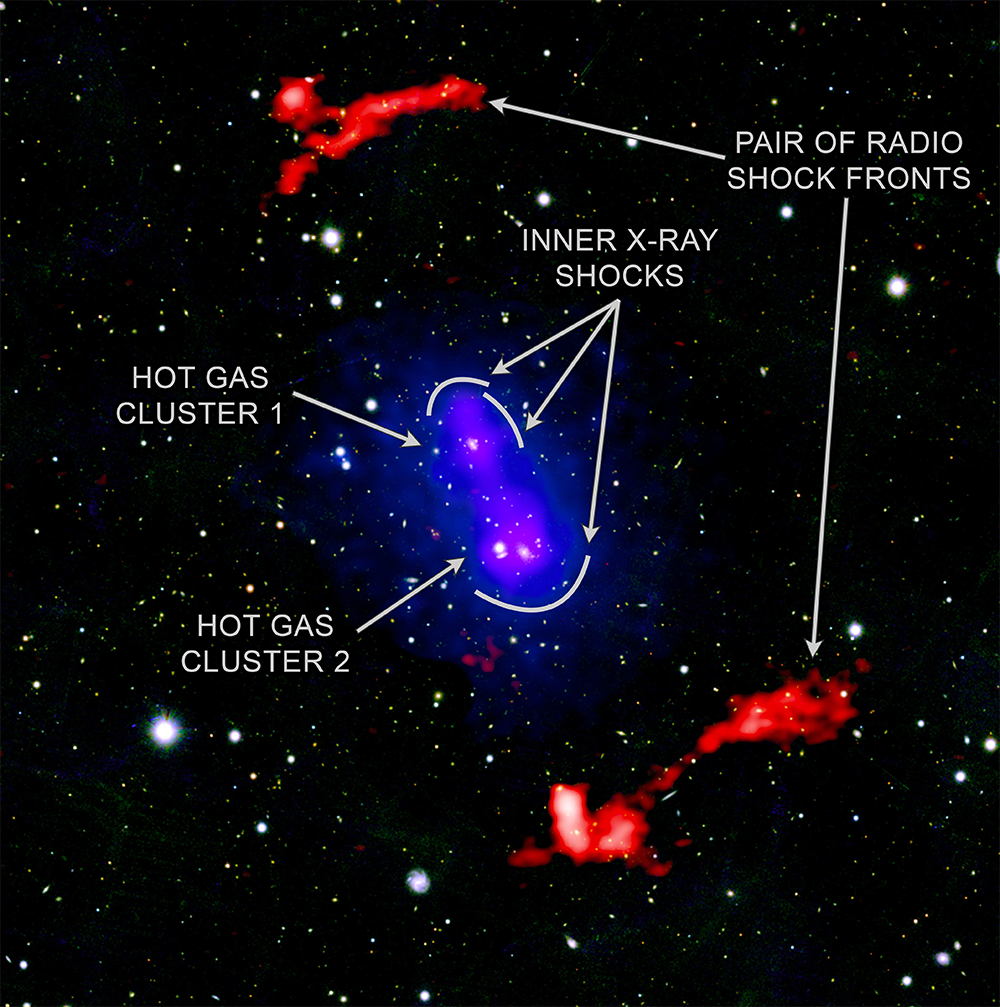For anyone disappointed that the Milky Way – our host galaxy – may not collide with our closest neighbor Andromeda after all, we have good news to keep your collision-hungry minds satisfied. Astronomers have spotted two clusters of galaxies that have collided, and appear to be lining up to smack into each other a second time.
Galaxy clusters are giant collections of sometimes hundreds or thousands of galaxies, all bound together by the gravity of their constituent galaxies’ baryonic (i.e. the normal matter we can see) and dark matter. They make up some of the largest structures in the universe, and will sometimes collide with each other to form larger clusters, unleashing vast amounts of energy in the process.
Around 2.8 billion light-years from Earth lies the galaxy cluster PSZ2 G181.06+48.47, or PSZ2 G181 for short. This galaxy cluster is believed to be made up of two smaller clusters that underwent a collision in the past.
Taking a closer look at the cluster, observations from the LOw Frequency ARray (LOFAR) in the Netherlands showed that there are two unusual features far from the center of mass. The cluster looks like it is enclosed in parentheses (brackets).

The shock fronts are highlighted in red.
Image credit: X-ray: NASA/CXC/CfA/Stroe, A. et al.; Optical: PanSTARRS; Radio: ASTRON/LOFAR; Image Processing: NASA/CXC/SAO/N. Wolk
Separated by a distance of around 11 million light-years, these structures are thought to be “shock fronts” resulting from the collision of the two galaxies around a billion years in the past (plus the 2.8-billion-year travel time for the light to reach our telescopes).
They are similar in nature to the shockwaves created when an aircraft breaks the sound barrier on Earth, and are likely caused by the gas disrupted by the colliding galaxies.
After further observations from NASA’s Chandra and ESA’s XMM-Newton telescopes, the bow shocks and galactic cluster collision is the subject of a set of three new studies.
“This separation is one of the largest among symmetric double radio relic clusters, suggesting an unusually late phase of the cluster merger,” the third paper on the topic explains.
Analyzing the galaxy and shock structures, the team believes there is evidence that the galaxy clusters are headed towards another collision.
“PSZ2 G181.06+48.47 is a low-mass post-core passage system, resulting from the merger of two subclusters along the N–NE–S–SW axis,” the first paper explains. “The post-merger scenario is strongly supported by the bridge of cool, low-entropy gas connecting the two subcluster cores, which indicates gas stripping during the first passage.”
The shock fronts are unusual in several ways, including that they are the lowest-mass system with these observed around them.
“The ∼370 kpc [kiloparsec] projected separation between the X-ray peaks of the two subclusters is dwarfed by comparison to the ∼2.6 Mpc projected separation between the two radio relics, complicating the interpretation of how double relics can form at such large separation, where the density of particles available for acceleration is very low,” that team adds. “If the merger axis is not in the plane of the sky, the two relics would be physically located even farther apart from each other […] The limited time available for evolution would then present new challenges in explaining how relics propagate to such large distances.”
That team believes a plausible scenario to explain the distance between the shocks is that the galaxy clusters are falling back into each other, and are on course for another collision.
“The existing observational evidence points to a late-stage, post-merger scenario with a significant [line of sight] component, where the two subclusters are seen post-apocenter as they are falling back into each other,” the team adds in their conclusion. “The outer shocks produced during the first encounter expand outward, reaching large radii over time, which would account for the large distance between the two relics.”
Further study and observations are needed to see what is going on here, and whether these low-mass cluster relics are a rare phenomenon or just the “tip of the iceberg”.
The studies are published in three papers in The Astrophysical Journal: paper one, paper two, and paper three.
Source Link: These Galactic Clusters Smashed Into Each Other. Giant Bow Shocks Suggest They're About To Go For Round 2